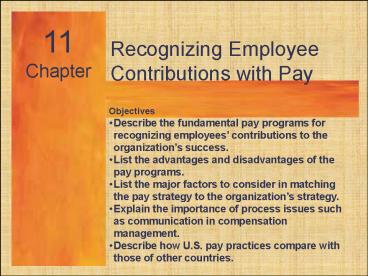Human Resource Management - PowerPoint PPT Presentation
1 / 15
Title:
Human Resource Management
Description:
Explain the importance of process issues such as communication in compensation management. ... of cooperation and information sharing. agreement on productivity ... – PowerPoint PPT presentation
Number of Views:67
Avg rating:3.0/5.0
Title: Human Resource Management
1
11 Chapter
Recognizing Employee Contributions with Pay
- Objectives
- Describe the fundamental pay programs for
recognizing employees contributions to the
organizations success. - List the advantages and disadvantages of the pay
programs. - List the major factors to consider in matching
the pay strategy to the organizations strategy. - Explain the importance of process issues such as
communication in compensation management. - Describe how U.S. pay practices compare with
those of other countries.
2
How Does Pay Influence Individuals?
12-2
- Equity Theory - chapter 11
- Reinforcement Theory
- Expectancy Theory - chapter 5
- Agency Theory
- principals as owners
- agents as managers
3
Types of Agency Costs
12-3
- Perquisites
- Attitudes toward risk
- Decision-making horizons
4
Factors in the Choice of a Compensation Package
12-4
- Risk Aversion
- Outcome Uncertainty
- Job Programmability
- Measurable Job Outcome
- Ability to Pay
- Tradition
5
Individual Pay Programs Design Features
12-5
Payment Method
Performance Measures
Frequency of Payout
Programs
Coverage
Merit Pay Incentive Pay Profit
Sharing Ownership Gainsharing Skill-based
- Change in base - Bonus - Bonus - Equity
changes - Bonus - Change in base
- Annually - Weekly - Semiannual or annual -
Sale of stock - Monthly / quarterly - when
skill is acquired
- Boss appraisal - Output, productivity -
Profit - Stock value - Production costs -
Skill acquisition
- All - Direct labor - All - All -
Production /service unit - All
6
Individual Pay Programs Consequences
12-6
Performance Motivation
Programs
Culture
Attraction
Costs
Merit Pay Incentive Pay Profit
Sharing Ownership Gainsharing Skill-based
- Change in base - little - some in small
units - Little - Little - Learning
- High performers - High performers - All
- All - Retain employees - those who
want to learn
- Individual competition - Intra-group
competition - Cooperation - Knowledge of
business - Sense of ownership - Learning
- High maintenance - Good system of
appraisal - Variable - Ability to pay - Cost
not variable - can be high
7
Individual Pay Programs Contingencies
12-7
Organization Structure
Management Style
Programs
Type of Work
Merit Pay Incentive Pay Profit
Sharing Ownership Gainsharing Skill-based
- Independent jobs - Measurable jobs /
units - Autonomous units - Any company -
Most companies - Most companies
- Control - Participation desirable -
Participation - Participation -
Participation - Participation
- Individual, easy to measure - Individual
appraisal - All types - All types - All
types - Professional
8
Merit Pay ProgramsCharacteristics
12-8
- Tries to identify individual performance
differences - Supervisor provides most performance information
- Pay is linked to performance appraisal results
- Feedback is infrequent
- Feedback is mostly one way - supervisor to
subordinate
9
Merit Pay ProgramsCriticisms
12-9
- Individual performance differences are due
largely to SYSTEM - Discourages teamwork
- System is not fair
- Too much reliance on supervisor for rating
- procedural issue
- Pay increase are not representative of
performance - distributive issue
- Contributes to entitlement mentality
10
Individual Incentives
12-10
Used rarely for the following reasons
- Most jobs have no physical output
- Many administrative problems
- Individuals focus only on the incentive
- Does not fit with team approach
- Does not reward obtaining multiple skills
- Rewards output at the expense of quality or
service
11
Profit Sharing
12-11
- Advantages
- Encourages employees to think like OWNERS
- Payments are not part of base pay
- Disadvantages
- Many plans defer actual payments
- Few plans pay out during business downturns
12
Ownership
12-12
- Similar to profit sharing with employee focus on
organizational success even stronger - Employee ownership through stock options
- Stock options typically reserved for executives,
however, the trend is toward pushing pushing
eligibility further down in the organization. - ESOPs
13
Gainsharing
12-13
- Encourages pursuit of broader(team) goals
- Measures performance that is controllable by
employee - Distributes payouts frequently
- Conditions for success include
- management commitment
- commitment to continuous improvement and change
- willingness to accept employee input
- high level of cooperation and information sharing
- agreement on productivity standards
- employment security
14
Process and Context Issues
12-14
- Employee participation in decision making
- Communication
- Pay and process intertwined effects
15
Matching Strategy to Operating Strategy
12-15
Business Unit Strategy
Defenders
Prospectors
Pay Strategy Dimension
Risk Sharing (variable pay) Time
Orientation Pay level (short run) Pay level
(long run) Benefits Level Where Pay Decision
Made Pay Unit of Analysis
Low Short-term Above market Above
market Above market Centralized Job
High Long-term Below market Above
market Below market Decentralized Skills































